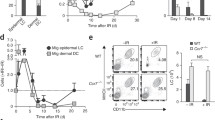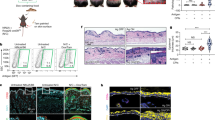Abstract
Urocanic acid (UCA) is formed in the epidermis where it accumulates to be converted fromtrans-tocis-UCA by ultraviolet (UV) radiation. The two isomers modulate immune functions in several experimental systems. In particular,cis-UCA has been shown to induce antigen-specific immune tolerance, but the molecular mechanism of this effect is unknown. The present investigation was instituted to disclose any effect of UCA isomers on the cellular expression of the costimulatory antigens CD80 (B7/BB-1) and CD28. CD80 expression was efficiently induced in monocytic (CD14+) cells by human interferon-γ, while CD28 levels on lymphocytes remained unchanged, as detected by flow cytometry. Neither UCA isomer showed any effect on the expression patterns of these costimulatory molecules. The results obtained suggest that the mode of action for epidermal UCA-induced tolerogenesis may not involve modulation of CD80 (B7/BB-1) or CD28 expression.
Similar content being viewed by others
References
Azuma M, Ito D, Yagita H, Okumura K, Phillips JH, Lanier LL, Somoza C (1993) B70 antigen is a second ligand for CTLA-4 and CD28. Nature 366:76
Caux C, Vanbervliet B, Massacrier C, Azuma M, Okumura K, Lanier LL, Banchereau J (1994) B70/B7-2 is identical to CD86 and is the major functional ligand for CD28 expressed on human dendritic cells. J Exp Med 180:1841–1847
Chang C-H, Furue M, Tamaki K (1995) B7-1 expression of Langerhans cells is up-regulated by proinflammatory cytokines, and is down-regulated by interferon-γ or by interleukin-10. Eur J Immunol 25:394–398
Damle NK, Klussman K, Linsley PS, Aruffo A (1992) Differential costimulatory effects of adhesion molecules B7, ICAM-1, LFA-3, and VCAM-1 on resting and antigen-primed CD4+ lymphocytes. J Immunol 148:1985–1992
Finn A, Strobel S, Levin M, Klein N (1994) Endotoxin-induced neutrophil adherence to endothelium: relationship to CD11b/CD18 and L-selectin expression and matrix disruption. Ann NY Acad Sci 725:173–182
Freedman AS, Freeman GJ, Rhynhart K, Nadler LM (1991) Selective induction of B7/BB-1 on interferon-γ-stimulated monocytes: a potential mechanism for amplification of T-cell activation through the CD28 pathway. Cell Immunol 137:429–437
Girolomoni G, Zambruno G, Manfredini R, Zacchi V, Ferrari S, Cossarizza A, Giannetti A (1994) Expression of B7 costimulatory molecule in cultured human epidermal Langerhans cells is regulated at the mRNA level. J Invest Dermatol 103:54–59
Grewe M, Gyufko K, Krutmann J (1995) Interleukin-10 production by cultured human keratinocytes: regulation by ultraviolet B and ultraviolet A1 radiation. J Invest Dermatol 104:3–6
Grey S, Hau H, Salem HH, Hancock WW (1993) Selective effects of protein C on activation of human monocytes by lipopolysaccharide, interferon-gamma, or PMA: modulation of effects on CD11b and CD14 but not on CD25 or CD54 induction. Transplant Proc 25:2913–2914
Grey ST, Tsuchida A, Hau H, Orthner CL, Salem HH, Hancock WW (1994) Selective effects of the anticoagulant activated protein C on the responses of human mononuclear phagocytes to LPS, IFN-gamma, or phorbol ester. J Immunol 153:3664–3672
Harriot-Smith TG, Halliday WJ (1988) Suppression of contact hypersensitivity by short term ultraviolet irradiation. II. The role of urocanic acid. Clin Exp Immunol 72:174–177
Kubin M, Kamoun M, Trinchieri G (1994) Interleukin-12 synergizes with B7/CD28 interaction in inducing efficient proliferation and cytokine production of human T cells. J Exp Med 180: 211–222
Laihia JK, Jansén CT (1994) Urocanic acid photoconversion in relation to erythematogenicity of radiation from different types of phototherapy equipment. Photodermatol Photoimmunol Photomed 10:13–16
Laihia JK, Jansén CT, Uksila J, Punnonen J, Neuvonen K, Pasanen P, Äyräs P (1994) Effects of cis- and trans-urocanic acids on the secretion of interleukin-1β and tumour necrosis factor-α by human peripheral blood monocytes. Acta Derm Venereol (Stockh) 74:266–268
Lanier LL, O’Fallon S, Somoza C, Phillips JH, Linsley PS, Okumura K, Ito D, Azuma M (1995) CD80 (B7) and CD86 (B70) provide similar costimulatory signals for T cell proliferation, cytokine production, and generation of CTL. J Immunol 154: 97–105
Liu Y, Jones B, Aruffo A, Sullivan KM, Janeway CA Jr (1992) Heat-stable antigen is a costimulatory molecule for CD4 T cell growth. J Exp Med 175:437–445
Luhtala M, Salomonsen J, Hirota Y, Onodera T, Toivanen P, Vainio O (1993) Analysis of chicken CD4 by monoclonal antibodies indicates evolutionary conservation between avian and mammalian species. Hybridoma 12:633–646
Minty A, Chalon P, Derocq J-M, Dumont X, Guillemot J-C, Kaghad M, Labit C, Leplatois P, Liauzun P, Miloux B, Minty C, Casellas P, Loison G, Lupker J, Shire D, Ferrara P, Caput D (1993) Interleukin-13 is a new human lymphokine regulating inflammatroy and immune responses. Nature 362:248–250
Mitra RS, Nickoloff BJ (1995) Modulation of emigration and maturation of dendritic cells (DCs) from human skin by cytokines and phorbol ester (TPA). J Invest Dermatol 104:615
Noonan FP, De Fabo EC (1992) Immunosuppression by ultraviolet B radiation: initiation by urocanic acid. Immunol Today 13: 250–254
Noonan FP, De Fabo EC, Morrison H (1988) Cis-urocanic acid, a product formed by ultraviolet B irradiation of the skin, initiates an antigen presentation defect in splenic dendritic cells in vivo. J Invest Dermatol 90:92–99
Norval M, Simpson TJ, Bardshiri E, Howie SEM (1989) Urocanic acid analogues and the suppression of the delayed type hypersensitivity respones toHerpes simplex virus. Photochem Photobiol 49:633–639
Nunès JA, Truneh A, Olive D (1996) Signal transduction by CD28 costimulatory receptor on T cells B7-1 and B7-2 regulation of tyrosine kinase adaptor molecules. J Biol Chem 271:1591–1598
Ozawa H, Aiba S, Nakagawa S, Tagami H (1995) The regulation of B7 expression on murine Langerhans cells (LC) by IL-10 and IFNγ. J Invest Dermatol 104:646
Pedron T, Girard R, Chaby R (1995) Variation of LPS-binding capacity, epitope expression, and shedding of membrane-bound CD14 during differentiation of human monocytes. J Immunol 155:1460–1471
Ross JA, Howie SEM, Norval M, Maingay J, Simpson T (1986) Ultraviolet irradiated urocanic acid suppresses delayed-type hypersensitivity toHerpes simplex virus in mice. J Invest Dermatol 18:630–633
Symington FW, Brady W, Linsley PS (1993) Expression and function of B7 on human epidermal Langerhans cells. J Immunol 150:1286–1295
Tan P, Anasetti C, Hansen JA, Melrose J, Brunvand M, Bradshaw J, Ledbetter JA, Linsley PS (1993) Induction of alloantigenspecific hyporesponsiveness in human T lymphocytes by blocking interaction of CD28 with its natural ligand B7/BB-1. J Exp Med 177:165–173
Teunissen MB, Rongen HA, Bos JD (1994) Function of adhesion molecules lymphocyte function-associated antigen-3 and intercellular adhesion molecule-1 on human epidermal Langerhans cells in antigen-specific T cell activation. J Immunol 152:3400–3409
Willems F, Marchant A, Delville J-O, Gérard C, Delvaux A, Velu T, de Boer M, Goldman M (1994) Interleukin-10 inhibits B7 and intercellular adhesion molecule-1 expression on human monocytes. Eur J Immunol 24:1007–1009
Wright SD, Ramos RA, Tobias PS, Ulevitch RJ, Mathison JC (1990) CD14, a receptor for complexes of lipopolysaccharide (LPS) and LPS binding protein. Science 249:1431–1433
Author information
Authors and Affiliations
Rights and permissions
About this article
Cite this article
Laihia, J.K., Uksila, J., Luhtala, M. et al. Expression of CD80 (B7/BB-1) and CD28 in human white blood cells treated with urocanic acid. Arch Dermatol Res 288, 570–574 (1996). https://doi.org/10.1007/BF02505258
Received:
Issue Date:
DOI: https://doi.org/10.1007/BF02505258




